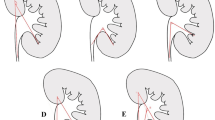Abstract
Background
The optimal management of lower pole kidney (LPK) stones in children is controversial. The aim of this study was to determine the outcomes of children with asymptomatic isolated LPK stones smaller than 10 mm during follow-up.
Methods
A total of 242 patients with 284 stones presenting at our institution between June 2004 and December 2014 with an asymptomatic, single LPK stone with a diameter of <10 mm were enrolled in the study. All children were assigned to receive first-line therapy and then categorized according to the need for medical intervention. Age, gender, stone laterality, stone size and type, associated urinary tract problems, and uncontrolled metabolic status were assessed as predictive factors of medical treatment for small (<10 mm) asymptomatic LPK stones. Stone-free rates were compared between interventions.
Results
The mean age and mean stone size were 9.4 ± 1.9 years and 7.4 ± 0.6 mm at admission, respectively. Stone progression rate was 61.2%, and the mean time for intervention was 19.2 ± 4.6 months. Flexible ureterorenoscopy (n = 68) or micro-percutaneous nephrolithotomy (n = 4) were performed for 72 stones (25.4%; group 1), and extracorporeal shock wave lithotripsy was performed for 102 stones (35.9%; group 2). The stone-free rates were 81.8 and 79.3% in group 1 and 2, respectively (p > 0.05). The remaining asymptomatic stones (110, 38.8%; group 3) were managed by continued observation, and at the end of the observation time (mean 40.8 ± 20.8 months) the spontaneous passage rate was 9.1% in this group. In the multivariate analysis, stone size of >7 mm, concurrent renal anomalies, and stones composed of magnesium ammonium phosphate (struvite) and cystine were statistically significant predictors of the need for intervention.
Conclusions
Children with stones larger than 7 mm, renal anomalies, or stones composed of metabolically active cystine or struvite are more likely to require intervention, and those with asymptomatic LPK stones smaller than 10 mm can be managed by continued observation.

Similar content being viewed by others
References
Novak TE, Lakshmanan Y, Trock BJ, Gearhart JP, Matlaga BR (2009) Sex prevalence of pediatric kidney stone disease in the United States: an epidemiologic investigation. Urology 74:104–107
Sarica K (2006) Pediatric urolithiasis: etiology, specific pathogenesis and medical treatment. Urol Res 34:96–101
Unsal A, Resorlu B, Kara C, Bozkurt OF, Ozyuvali E (2010) Safety and efficacy of percutaneous nephrolithotomy in infants, preschool age, and older children with different sizes of instruments. Urology 76:247–252
Tekgul S, Dogan HS, Erdem E, Hoebeke P, Kocvara R, Nijman JM, Radmayr C, Silay MS, Stein R, Undre S (2015) Guidelines on paediatric urology. European Association of Urology. http://uroweb.org/wp-content/uploads/23-Paediatric-Urology_LR_full.pdf Accessed 10 Dec 2015
Glowacki LS, Beecroft ML, Cook RJ, Pahl D, Churchill DN (1992) The natural history of asymptomatic urolithiasis. J Urol 147:319–321
Burgher A, Beman M, Holtzman JL, Monga M (2004) Progression of nephrolithiasis: long-term outcomes with observation of asymptomatic calculi. J Endourol 18:534–539
Koh LT, Ng FC, Ng KK (2012) Outcomes of long-term follow-up of patients with conservative management of asymptomatic renal calculi. BJU Int 109:622–625
Inci K, Sahin A, Islamoglu E, Eren MT, Bakkaloglu M, Ozen H (2007) Prospective long-term followup of patients with asymptomatic lower pole caliceal stones. J Urol 177:2189–2192
Altunrende F, Tefekli A, Stein RJ, Autorino R, Yuruk E, Laydner H, Binbay M, Muslumanoglu AY (2011) Clinically insignificant residual fragments after percutaneous nephrolithotomy: medium-term follow-up. J Endourol 25:941–945
Dincel N, Resorlu B, Unsal A, Tepeler A, Silay MS, Armağan A, Diri A, Sancaktutar AA, Ziypak T, Mir S (2013) Are small residual stone fragments really insignificant in children? J Pediatr Surg 48:840–844
Oner A, Demircin G, Ipekcioglu H, Bülbül M, Ecin N (1997) Etiological and clinical patterns of urolithiasis in Turkish children. Eur Urol 31:453–458
Gross AJ, Fisher M (2006) Management of stones in patients with anomalously sited kidneys. Curr Opin Urol 16:100–105
Author information
Authors and Affiliations
Corresponding author
Ethics declarations
Conflict of interest
The authors declare no conflict of interest.
Rights and permissions
About this article
Cite this article
Telli, O., Hamidi, N., Bagci, U. et al. What happens to asymptomatic lower pole kidney stones smaller than 10 mm in children during watchful waiting?. Pediatr Nephrol 32, 853–857 (2017). https://doi.org/10.1007/s00467-016-3570-7
Received:
Revised:
Accepted:
Published:
Issue Date:
DOI: https://doi.org/10.1007/s00467-016-3570-7



